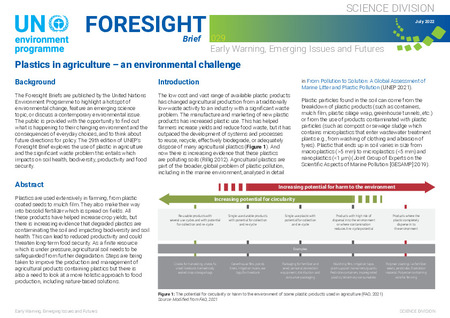| dc.contributor | Science Division | en_US |
| dc.contributor.author | United Nations Environment Programme | en_US |
| dc.contributor.other | Baker, Elaine | en_US |
| dc.contributor.other | Thygesen, Kristina | en_US |
| dc.coverage.spatial | Global | en_US |
| dc.date.accessioned | 2022-07-26T08:07:37Z | |
| dc.date.available | 2022-07-26T08:07:37Z | |
| dc.date.issued | 2022-07 | |
| dc.identifier.uri | https://wedocs.unep.org/20.500.11822/40403 | |
| dc.description | Plastics are used extensively in farming, from plastic coated seeds to mulch film. They also make their way into biosolid fertilizer which is spread on fields. All these products have helped increase crop yields, but there is increasing evidence that degraded plastics are contaminating the soil and impacting biodiversity and soil health. This can lead to reduced productivity and could threaten long-term food security. As a finite resource which is under pressure, agricultural soil needs to be safeguarded from further degradation. Steps are being taken to improve the production and management of agricultural products containing plastics but there is also a need to look at a more holistic approach to food production, including nature-based solutions. | en_US |
| dc.format | Text | en_US |
| dc.language | English | en_US |
| dc.language | French | |
| dc.rights | Public | en_US |
| dc.subject | plastic | en_US |
| dc.subject | plastic product | en_US |
| dc.subject | agricultural pollution | en_US |
| dc.subject | plastic pollution | en_US |
| dc.subject | agricultural production | en_US |
| dc.title | Plastics in Agriculture - an Environmental Challenge - Foresight Brief No. 029 July 2022 | en_US |
| dc.title.alternative | L’utilisation des plastiques dans l’agriculture – un enjeu environnemental - Note Perspective No. 029 Juillet 2022 | |
| wd.identifier.sdg | SDG 12 - Responsible Consumption and Production | en_US |
| wd.identifier.sdg | SDG 15 - Life on Land | en_US |
| wd.topics | Chemicals and Pollution Action | en_US |
| wd.identifier.pagesnumber | 8 pages | en_US |



